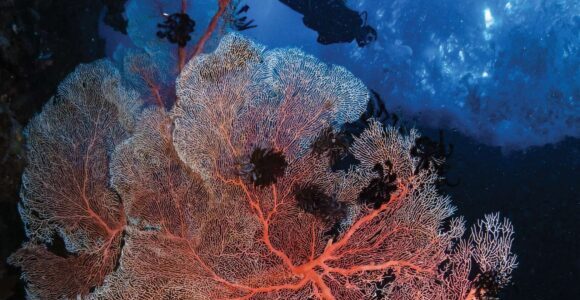Underwater photographer Karen Ho checks into the remote Tawali Resort at Milne Bay to explore a range of scuba diving sites.

The gorgonian sea fan at Deacon’s Reef made famous by National Geographic. Credit: Karen Ho
There are many ways to explore Milne Bay. I’ve chosen to stay at Tawali Leisure and Dive Resort, which is on the remote north coast.
After a short flight from Port Moresby to Alotau with Air Niugini, it’s a further two hours by bus and boat to the resort, which perches on a volcanic bluff overlooking unspoilt waters.
Tawali was built by local craftsmen, so there are carved totems and woodwork through the resort. There’s a large central main lodge and guest bungalows connected by covered walkways.
Being an underwater photography enthusiast, I’m here to explore the range of dive sites the region has to offer, including Lauadi at Dinah’s Beach.
The term ‘muck diving’ (exploring muddy or sandy bottoms of the sea) is usually associated with Anilao in the Philippines and Lembeh in Indonesia, but the practice was in fact forged in Papua New Guinea.
Back in the 1980s, when celebrated underwater photographer and Milne Bay scuba diving pioneer Bob Halstead and his wife Dinah were exploring the fringing reefs around the north coast of Milne Bay, Bob discovered that the muddy black sediment in the water just out from Lauadi (the village Dinah was from), was full of rare sea creatures that could not be found on the coral reefs.
- A tiger butterfly nudibranch at Lauadi. Credit: Karen Ho
- A sap-sucking sea slug. Credit: Karen Ho
- A manta ray. Credit: Karen Ho
- A coral seascape at Tania’s Reef near Tawali. Credit: Karen Ho.
In the water in front of the village, the beach slopes at about 30 degrees. Divers only need to descend to about 10 metres where a lot of the rare sea creatures, such as the tiger butterfly sea slug (Cyerce nigra), can be found with a keen eye.
If you’re diving without a camera, it’s a good idea to take a magnifying glass to see the smallest animals, which may be just five millimetres long.
About five minutes from Lauadi, the topography and underwater scenery change dramatically from a muddy bottom to picturesque coral reef that is visible through the crystal-clear water from the surface.
Unlike most sites, where you start your dive at the drop-offs, at Deacon’s Reef, right by the cliff edge, you will encounter one of the most famous sea fans in PNG, photographed by David Doubilet for a double-page spread in a National Geographic magazine in the 1980s.
Needless to say, I made my best attempt at re-creating that famous photograph, and I was pleased with the result.
At night, there is good opportunity for ‘black water photography’ on the house reef just 200 metres from Tawali. The reef is full of life and it’s like watching a nocturnal party of sea life.
The reef starts in shallow 10-metre water but then drops sharply. Many of the species that reside in the deep rise and feed in shallower water at night.
Apart from the many dive sites in the area, there are World War 2 plane wrecks to explore, such as the famous ‘Black Jack’ B-17F Flying Fortress bomber.
Snorkellers aren’t left out either. There are plenty of sites for them, including Boi Boi Waga Island, with a white sandy beach where you can go for a
day of snorkelling and a picnic.
On land, you can visit waterfalls and hot springs, do a coastal village walk, go birdwatching, venture into Skull Cave and enjoy a mumu (traditional stone cooking).
Tawali has a range of rooms from doubles to deluxe bungalows with private balconies with sea views. Meals are included with accommodation and prices are listed at tawali.com.
Air Niugini flies from Port Moresby to Alotau (Gurney) 12 times a week.
See airniugini.com.pg.
This is an edited version of an article first published in the August-October 2025 issue of Paradise, the in-flight magazine of Air Niugini.













Speak Your Mind